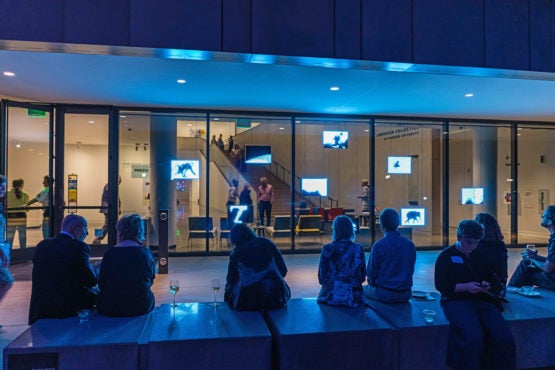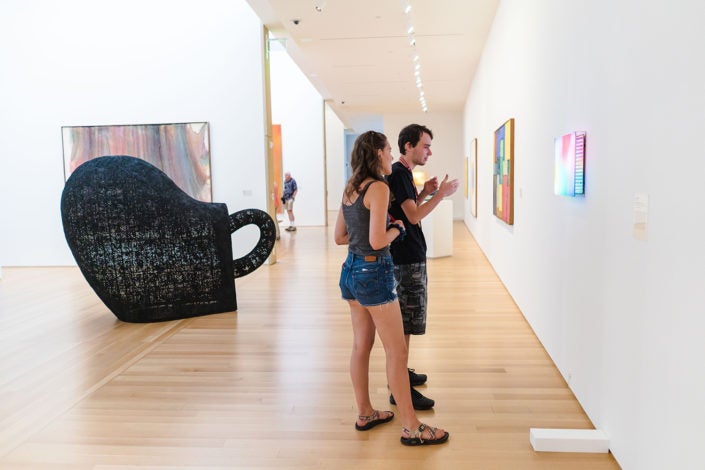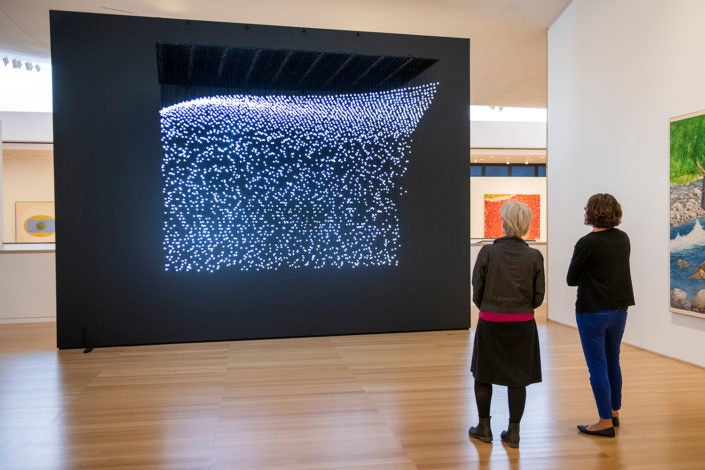The light-based works of Jim Campbell flicker and ebb at the Anderson Collection at Stanford University
Campbell’s electrified works prompt visitors to see the surrounding permanent collection in a new light.
A temporary exhibition of light-based works by Jim Campbell is on view at the Anderson Collection at Stanford University through Aug. 3, 2020. Eleven of the artist’s large- and small-scale works are installed throughout the permanent collection of post-war American art on both floors of the museum.

Guests at the Anderson Collection’s fifth-anniversary celebration view “Rhythm Studies studies” (2019) by Jim Campbell through the lobby windows. The site-specific work was created to be viewed from inside and outside of the museum. (Image credit: Harrison Truong)
This exhibition marks the first time Campbell has attempted to mix his work within a museum’s permanent collection. He did so at the urging of Jason Linetzky, the director of the Anderson Collection, who invited Campbell to be part of the museum’s fifth-anniversary celebration.
Both Linetzky and Campbell saw the potential from the partnership. Hosting the exhibition is a way to re-engage with and rethink the permanent collection, Linetzky said.
For Campbell, the project provided an opportunity to discover new relationships between his work and the art on display at the Anderson Collection.
In his art, Campbell uses arranged light-emitting diodes (LED) to suggest movement and recognizable figures. The work requires the viewer to extrapolate form based on limited digital data and video imagery in motion. He considers his work experiments in perception that are more films than sculpture.
“In its abstract orientation and encouragement of extended contemplation, Campbell’s art has much in common with the vibrant, light-filled and expansive works in the Anderson Collection,” wrote Jennie Waldow, PhD candidate in the Department of Art and Art History in the School of the Humanities and Sciences, who worked on the exhibition text panels. “While many of Campbell’s public projects have been physically sweeping in scale, such as Day for Night (2018), his recent installation atop the Salesforce Tower in San Francisco, this exhibition focuses on his more intimate works, placing them in conversation with the Anderson’s permanent collection to create new sensory and thematic resonances.”
One of the artist’s favorite “conversations” is between Hans Hofmann’s Fall Euphony (1959), a play of warm and cool blocks of color that create a three-dimension illusion of advancing and receding shapes, with his own Edition 26 (Temple in Yunnan) (2018), which might be viewed as a minimalist interpretation of the Hofmann. Grand Central Station #4 (2009) and Christopher Brown’s painting 1946 (1992) is another favorite pairing because they both depict blurred figures in motion.

Visitors compare Jim Campbell's Edition 26 (Temple in Yunnan) (2018) with the adjacent painting by Hans Hofmann titled Fall Euphony (1959) at the Anderson Collection. (Image credit: Harrison Truong)

Jim Campbell used 3,456 LED lights to create Eroding Wave (2016) on view at the Anderson Collection. (Image credit: L.A. Cicero)
“The museum’s fifth anniversary presented an exciting opportunity to rethink the presentation of the permanent collection and bring into conversation the work of a celebrated contemporary artist,” Linetzky said. “Campbell’s electrified works prompt visitors to see the surrounding permanent collection in a new light. The pairings bring a renewed awareness to the collection and Campbell’s work by offering unique and surprising avenues of inquiry.”
A Campbell work that connects not just to the Anderson Collection but to Leland Stanford and the university is Rhythm Studies studies (2019), which was specifically created for the first-floor lobby windows where it can be viewed from inside and the outside of the museum. Custom electronics, LEDs and treated Plexiglas re-present imagery from Eadweard Muybridge’s groundbreaking human and animal motion studies that he worked on with then-Senator Leland Stanford in the late 1800s. Muybridge devised a method of sequential still photographs to capture aspects of bodily motion undetectable by the human eye. In Rhythm Studies studies, Campbell breaks down Muybridge’s images into minimal data with continual variations in magnification.
Trained in electrical engineering and mathematics at Massachusetts Institute of Technology, Campbell designed computer chips in Silicon Valley for 25 years. He was interested in film and photography in college and began creating new media art in the mid-1980s. Waldow observes in her text panels that, for the last 20 years, Campbell has primarily utilized LEDs to recreate scenes of jostling crowds, home movies and the movements of natural forms such as waves and clouds.
The Anderson Collection and the Cantor Arts Center will close at 3 p.m. on Wednesday, Nov. 27. They will be closed on Thanksgiving day and will reopen with regular hours on Friday, Nov. 29.
